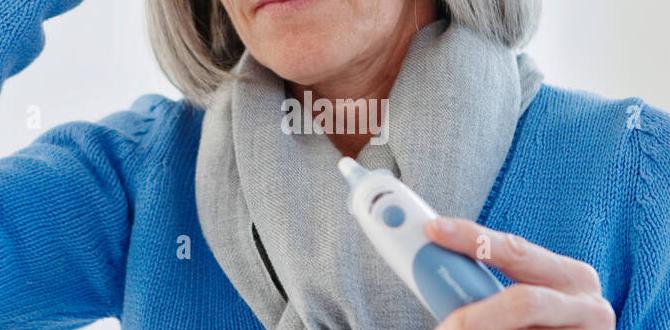Have you ever wondered what outdoor temperature is dangerous for the elderly? Imagine a sunny day at the park. While most people enjoy the warmth, the elderly might feel differently.
Many older adults are more sensitive to temperature changes. What seems comfortable for you might be risky for them. Did you know that extreme heat or cold can lead to serious health problems? This can be especially true in the summer and winter months.
Understanding the right outdoor temperature for seniors can make a big difference. It can help keep them safe and happy. Let’s explore the temperatures that could be harmful. By being aware, we can protect our loved ones and ensure they enjoy the great outdoors safely.
What Outdoor Temperature Is Dangerous For Elderly Individuals? As We Age, Our Bodies Undergo Various Changes That Can Affect Our Ability To Regulate Temperature. For Elderly Individuals, Exposure To Extreme Outdoor Temperatures Can Lead To Serious Health Risks. Understanding What Outdoor Temperature Is Dangerous For The Elderly Can Help In Mitigating These Risks And Ensuring Their Safety. Understanding Temperature Sensitivity In The Elderly Elderly Individuals Often Experience Reduced Thermal Sensitivity. This Means They May Not Be Able To Recognize Extreme Weather Conditions Promptly. As A Result, They Are At A Higher Risk For Temperature-Related Illnesses, Including Heat Exhaustion And Hypothermia. Dangerous Heat Conditions During The Summer Months, Outdoor Temperatures Above 90°F (32°C) Can Become Dangerous For The Elderly. Factors Such As Dehydration, Medications That Affect Hydration Levels, And Underlying Health Conditions Can Exacerbate The Risks Associated With Heat. Signs Of Heat Exhaustion Include Heavy Sweating, Weakness, And Dizziness, Which Require Immediate Attention. Risky Cold Conditions Conversely, In Winter, Temperatures That Fall Below 32°F (0°C) Can Pose Significant Risks For Elderly Individuals. Cold Weather Can Lead To Hypothermia, Which Occurs When The Body Loses Heat Faster Than It Can Produce It. Symptoms Of Hypothermia Include Shivering, Confusion, And Decreased Dexterity, All Of Which Can Be Dangerous. Factors Contributing To Temperature Sensitivity Several Factors Can Contribute To Elderly Individuals’ Sensitivity To Outdoor Temperatures: 1. **Chronic Health Conditions**: Heart Disease, Respiratory Issues, And Diabetes Can Affect How The Body Responds To Temperature Extremes. 2. **Medications**: Some Medications Can Affect Blood Flow Or Reduce The Body’S Ability To Regulate Temperature. 3. **Hydration Levels**: Dehydration Can Occur More Rapidly In Elderly Individuals, Making It More Difficult For Them To Handle Heat. 4. **Mobility Issues**: Difficulty In Moving Can Prevent Elderly People From Seeking Shelter During Extreme Weather. Safety Tips For Outdoor Temperatures To Keep Elderly Individuals Safe During Extreme Weather Conditions, Consider The Following Tips: – **Monitor Weather Conditions**: Always Check The Weather Forecast Before Outdoor Activities And Limit Exposure During Extremes. – **Stay Hydrated**: Ensure Adequate Hydration, Especially In Warmer Months, As Dehydration Can Increase The Risk Of Heat-Related Illnesses. – **Dress Appropriately**: In Both Cold And Hot Weather, Wearing The Right Clothing Can Help Maintain A Safe Body Temperature. – **Check On Loved Ones**: Regularly Check On Elderly Family Members Or Friends To Ensure They Are Safe And Comfortable During Extreme Temperatures. Conclusion Understanding What Outdoor Temperature Is Dangerous For Elderly Individuals Is Crucial For Ensuring Their Safety And Well-Being. By Taking Proactive Measures And Being Aware Of The Risks Associated With Extreme Weather, Caregivers Can Significantly Reduce The Potential Health Hazards Faced By The Elderly During Temperature Fluctuations.

What Outdoor Temperature is Dangerous for Elderly
Extreme temperatures can pose serious risks for the elderly. When it’s too hot, seniors might experience heat exhaustion or heat stroke. The body’s ability to cool down decreases with age. Conversely, cold weather can lead to hypothermia, as older adults may not realize how cold it is. What’s the safe range? Ideally, keep them indoors when temperatures are below 32°F (0°C) or above 90°F (32°C). Always check on older friends and family, especially during weather extremes!Understanding Elderly Vulnerability to Temperature Extremes
Physiological changes in aging bodies. Common health issues that exacerbate temperature sensitivity.As we age, our bodies change in many ways. One major shift is how we react to heat and cold. Older adults often have slower reactions to temperature changes. This makes it harder for them to stay cool in the heat or warm in the cold. Common health issues, like heart disease and diabetes, can add to this challenge. It’s like having a super-sensitive temperature gauge! About 85% of seniors face these issues, making them extra vulnerable to extremes. Let’s dive into this with a quick look:
| Health Issue | Effect on Temperature Sensitivity |
|---|---|
| Heart Disease | Can struggle with blood circulation. |
| Diabetes | May cause nerve damage affecting temperature perception. |
| Respiratory Problems | Make it hard to breathe in hot or cold weather. |
So, keeping an eye on those temps is super important! After all, no one wants Grandma turning into a popsicle or Grandpa sweating like he just ran a marathon!
Temperature Guidelines for Seniors
Safe temperature ranges for outdoor activities. Indicators of potentially dangerous temperatures.Outdoor temperatures can affect seniors. The safe range for outdoor activities is between 50°F and 85°F. In this zone, seniors can enjoy being outside without worrying too much. However, temperatures above 90°F or below 40°F can be risky. These temperatures may lead to serious issues. Watch for signs of heat exhaustion or hypothermia. Quick action can keep seniors safe and healthy.
What temperatures are dangerous for seniors?
Above 90°F and below 40°F are dangerous for seniors. Avoid outdoor activities during these times.
Indicators of dangerous temperatures:
- Heavy sweating or dizziness in heat
- Shivering or confusion in cold
- Feeling faint or weak
Signs of Temperature-Related Risks
Symptoms of heat exhaustion and heatstroke. Indicators of hypothermia in cold weather.Hot weather can cause trouble for older folks. Heat exhaustion is one sign. Look for heavy sweating, weakness, and a fast heartbeat. If someone feels dizzy or confused, it’s serious. That could lead to heatstroke, which is life-threatening. Cold weather also brings risks. Hypothermia happens when the body gets too cold. Watch for shivering, slow speech, or confusion. It’s important to know these signs and act fast if you see them.
What are the signs of heat exhaustion and heatstroke?
Common signs include:
- Heavy sweating
- Weakness and dizziness
- Rapid heartbeat
- Confusion
If someone has these signs, take action quickly.
What are the indicators of hypothermia in cold weather?
Look for these signs:
- Shivering
- Slow or slurred speech
- Weak pulse
- Confusion
Recognizing these symptoms can save lives. Always keep an eye on older adults during extreme temperatures.
Preventative Measures for Extreme Temperatures
Preparing seniors for outdoor exposure. Importance of hydration and appropriate clothing.Keeping seniors safe in extreme temperatures is very important. First, prepare them for outdoor activities. Make sure they wear light, breathable clothing. Sunscreen is also essential. Always remind them to drink plenty of water. Staying hydrated helps prevent heat-related issues. Be aware of early signs of heat exhaustion, like dizziness or confusion.
- Light clothing protects against heat.
- Hydration is key; drink water often.
- Check on seniors more frequently in extreme weather.
What outdoor temperature is dangerous for elderly?
Temperatures above 90°F (32°C) can be very dangerous for elderly people. Heat affects their bodies differently. They are at higher risk of heat-related illnesses.
Emergency Responses for Temperature-Related Health Issues
First aid for heatrelated illnesses. Steps to take in case of coldrelated emergencies.Heat and cold can be dangerous for the elderly. Quick action is important. For heat-related illnesses, here’s what to do:
- Move the person to a cool place.
- Loosen or remove tight clothing.
- Give them cool water to drink.
- Apply cool, wet cloths to their skin.
For cold-related emergencies, follow these steps:
- Get the person indoors right away.
- Remove wet clothing.
- Wrap them in warm blankets.
- Give them warm drinks if they are alert.
Time is important. The faster you act, the better chances the person has to feel better.
What are the common signs of temperature-related health issues?
Common signs include confusion, extreme fatigue, and shivering for cold or heat exhaustion symptoms like heavy sweating, headache, and dizziness.
Resources and Support for Seniors
Community programs for safe outdoor activities. Helplines and resources for family caregivers.Staying active is key for seniors, but they need a helping hand! Community programs can help them enjoy the outdoors safely. These programs often offer guided activities like walking clubs and gardening classes, which are perfect for sunny days. Families can also find fantastic resources to support their loved ones. Helplines provide answers to questions and advice for caregivers. Remember, a little support goes a long way, and laughter is great medicine!
| Program Type | Description |
|---|---|
| Walking Clubs | Organized group walks to keep seniors active and social. |
| Gardening Classes | Fun ways to learn and enjoy nature at the same time. |
| Caregiver Helplines | Help with questions and support for family caregivers. |
Long-term Strategies for Temperature Safety
Home modifications for temperature control. Establishing a regular checkin system for elderly individuals.Keeping seniors safe in extreme temperatures is important. Simple home changes can help. Air conditioning or fans provide coolness in summer. In winter, heating systems can keep them warm. Regular check-ins also help. Family or friends can call or visit to see how they are. A caring routine ensures they feel loved and safe.
What Home Modifications Help Seniors?
Some good changes are:
- Install thermostats to control indoor temperature easily.
- Keep windows and doors sealed for better insulation.
- Provide cozy blankets for cold days.
Why Are Regular Check-Ins Important?
Regular check-ins can show if a senior needs help. It helps to:
- Ensure they are comfortable and healthy.
- Identify any temperature issues they may face.
Conclusion
In conclusion, elderly people are most at risk in extreme temperatures. Heat above 90°F and cold below 32°F can be dangerous. Always check the temperature and limit outdoor activities in extremes. Stay hydrated and dress appropriately. For more tips on keeping safe outdoors, read articles on senior health and safety. Let’s keep our elders safe together!FAQs
What Specific Temperature Range Is Considered Dangerous For Elderly Individuals During Hot Weather?For elderly people, temperatures above 90°F (32°C) can be very dangerous. When it gets this hot, they can easily get too hot. This can lead to heat exhaustion or heat stroke, which can make them very sick. It’s important to keep them cool and give them plenty of water. Always check on them during hot days!
How Does Cold Weather Affect The Elderly, And What Temperatures Should Caregivers Be Especially Cautious Of?Cold weather can make it hard for older people to stay warm. They might feel colder than younger people do. This can lead to problems like frostbite or being very sick. Caregivers should be extra careful when the temperature drops below 32°F (0°C). It’s important to keep elderly people warm and check on them often during cold days.
What Symptoms Should Caregivers Watch For In Elderly Individuals When Outdoor Temperatures Are At Extreme Highs Or Lows?When it’s really hot outside, watch for signs of heat exhaustion. This can include dizziness, sweating a lot, or feeling very tired. When it’s very cold, look for shivering, confusion, or cold, pale skin. We should help them drink water or dress warmly to stay safe. Always call a doctor if we notice these symptoms.
What Precautions Can Be Taken To Protect Elderly Individuals From Dangerous Outdoor Temperatures?To keep elderly people safe in hot or cold weather, we can help them dress warmly or wear lighter clothes. We should encourage them to stay inside when it’s too hot or too cold outside. It’s important to drink water to stay hydrated, especially in the heat. Checking on them regularly makes sure they are okay. Using fans or heaters can also help keep them comfortable.
How Does Humidity Impact The Safety Of Elderly Individuals During High-Temperature Days?Humidity makes the air feel hotter, which can be dangerous for elderly people. When it’s humid, they sweat less and can overheat. Overheating can cause dizziness, tiredness, or even sickness. It’s important for elderly folks to stay cool, drink water, and avoid going outside during hot, humid days.
{“@context”:”https://schema.org”,”@type”: “FAQPage”,”mainEntity”:[{“@type”: “Question”,”name”: “What Specific Temperature Range Is Considered Dangerous For Elderly Individuals During Hot Weather? “,”acceptedAnswer”: {“@type”: “Answer”,”text”: “For elderly people, temperatures above 90°F (32°C) can be very dangerous. When it gets this hot, they can easily get too hot. This can lead to heat exhaustion or heat stroke, which can make them very sick. It’s important to keep them cool and give them plenty of water. Always check on them during hot days!”}},{“@type”: “Question”,”name”: “How Does Cold Weather Affect The Elderly, And What Temperatures Should Caregivers Be Especially Cautious Of? “,”acceptedAnswer”: {“@type”: “Answer”,”text”: “Cold weather can make it hard for older people to stay warm. They might feel colder than younger people do. This can lead to problems like frostbite or being very sick. Caregivers should be extra careful when the temperature drops below 32°F (0°C). It’s important to keep elderly people warm and check on them often during cold days.”}},{“@type”: “Question”,”name”: “What Symptoms Should Caregivers Watch For In Elderly Individuals When Outdoor Temperatures Are At Extreme Highs Or Lows? “,”acceptedAnswer”: {“@type”: “Answer”,”text”: “When it’s really hot outside, watch for signs of heat exhaustion. This can include dizziness, sweating a lot, or feeling very tired. When it’s very cold, look for shivering, confusion, or cold, pale skin. We should help them drink water or dress warmly to stay safe. Always call a doctor if we notice these symptoms.”}},{“@type”: “Question”,”name”: “What Precautions Can Be Taken To Protect Elderly Individuals From Dangerous Outdoor Temperatures? “,”acceptedAnswer”: {“@type”: “Answer”,”text”: “To keep elderly people safe in hot or cold weather, we can help them dress warmly or wear lighter clothes. We should encourage them to stay inside when it’s too hot or too cold outside. It’s important to drink water to stay hydrated, especially in the heat. Checking on them regularly makes sure they are okay. Using fans or heaters can also help keep them comfortable.”}},{“@type”: “Question”,”name”: “How Does Humidity Impact The Safety Of Elderly Individuals During High-Temperature Days? “,”acceptedAnswer”: {“@type”: “Answer”,”text”: “Humidity makes the air feel hotter, which can be dangerous for elderly people. When it’s humid, they sweat less and can overheat. Overheating can cause dizziness, tiredness, or even sickness. It’s important for elderly folks to stay cool, drink water, and avoid going outside during hot, humid days.”}}]}







